| Latest | Greatest | Lobby | Journals | Search | Options | Help | Login |
|
|
|
This topic is archived. |
| Home » Discuss » Topic Forums » Sports |
|
| Jack Rabbit
|
Sun Sep-27-09 02:03 AM Original message |
| The JR Chess Report (September 27): Kasparov and Karpov Celebrate Their Rivalry |
|
Edited on Sun Sep-27-09 02:08 AM by Jack Rabbit
Kasparov and Karpov Celebrate Rivalry in Rapid/Blitz Match
 Garry Kasparov won three out of four rapid games and five out of eight blitz games to win his much anticipated exhibition match against his old rival, Anatoly Karpov, in Valencia, Spain last week by a 9-3 score. The match began Tuesday with two rapid games on the twenty-fifth anniversary of the start of 1984 world championship match between the two legendary chess players. Between 1984 and 1990, the two would play five matches with the world chess championship at stake in each. The first match was abandoned after 48 games, Kasparov narrowly won the second and third, the fourth ended in a 12-12 tie with Kasparov retaining the title and Kasparov won the 1990 match 12�-11�. There will be another rapid/blitz match between the two great rivals in Paris in December. By winning the second match in 1985, Kasparov, then 22, became the youngest ever world chess champion. Kasparov, now 46, is today a leader of the political opposition to Russian strongman Vladimir Putin and has only engaged in occasional chess exhibitions or rapid/blitz matches since announcing his retirement after the Linares Tournament of 2005, in which Kasparov shared first prize with Bulgarian GM Veselin Topalov. Karpov is reputed to be the wealtiest man in Russia with investments in petroleum production. He seldom plays in a standard time control chess tournament nowadays, reserving most of his energy to rapid tournaments and exhibitions. The rivalry betweeen the two is rightly regarded one of the greatest in sports history. Sutovsky Runs off with Antwerp Tournament http://2.bp.blogspot.com/_Q0lTtPVTG40/SrRwFX0Kq9I/AAAAAAAA8dI/RP-TbqRguVo/s400/AOL+Beta+-+Connected,+Signed-On+9192009+124250+AM.jpg Israeli grandmaster Emil Sutovsky, his country's second ranked player behind Boris Gelfand, won the nventi Chess Tournament in Antwerp with 7 points out of a possible 9. GMs Etienne Bacrot of France and Krishnan Sasikiran of India tied for a distant second with 5� points each. SPICE Cup: Three Grandmasters Tied with Four Wins among Them http://4.bp.blogspot.com/_Q0lTtPVTG40/Sqlz4zfpsTI/AAAAAAAA7_o/FabWgEut9uc/S217/2009+SPICE+Cup+TTU+Cover+2.tif.jpg In a tournament featuring a number of fighting draws but few decisive games, three grandmasters go into today's eighth round tied for first place in the SPICE Cup Tournament on the campus of Texas Tech University in Lubbock. They are Jon Ledvig Hammer of Norway, Ukrainian Yuriy Kuzubov and Russia's Dmitry Andreikin. Jon Ludvig is the only player in the tournament with two victories to his credit; Kuzubov and Andreikin each have one win and seven draws. A B-Group tournament is taking place at the same time. In that tournament, American IM Ben Feingold clinched his final necessary grandmaster norm today. Feingold, with 6 points out of eight, leads the B-Group by one point over American GMs Vinay Bhat and Eugene Perelshteyn and 14-year-old IM Ray Robson. Young Robson needs a win tomorrow to secure his final GM norm. If he is successful, he will become the youngest American chess grandmaster ever, a distinction currently held by the late Bobby Fischer. The B-Group tournament ends tomorrow while the A-Group will fight it out until Tuesday. The event was organized by the Susan Polgar Institute for Chess Excellence (SPICE), which is affiliated with Texas Tech University. Short Bests Efimenko in 6-Game Match  Resurgent British GM Nigel Short defeated Zahar Efimenko of Ukraine in a six-game match with two wins against one last week in the western Ukrainian town of Mukachevo. Efimenko, 20 years younger than his opponent, struck in round one with a victory with Black, but Short came back in round 2 to score a Black win of his own. Rounds three and four were drawn, but Short scored in his final White game in round five before the sixth round was drawn yesterday, ending the match. The match was organized by UEP, which also organized last year's Anand-Kramnik world championship match in Bonn, Germany. Wang Yue and Hou Yifan Crowned in Jinzhou  Grandmasters Wang Yue and Hou Yifan are the King and Queen of Chinese Chess after winning their repective groups at the Maotai Prince Cup National Tournament in Jinzhou last week. Each division (men's and women's) played seven rounds. Wang took 5 points to beat out fellow grandmaster Wang Hao by a half point. Ms. Hou scored 5� points and needed a final-round victory over reigning Chinese women's champion Shen Yang edge Ju Wengen by a half point. Calendar Second Pearl Spring Tournament, Nanjing 28 September-9 October. 10 rounds. Carlsen, Jakovenko, Leko, Radjabov, Topalov, Wang Yue. Women's FIDE Grand Prix, Nanjing 28 September-9 October. 11 Rounds. Zhao Xue, Ju Wengen, Dzagnidze, Sebag, Xu Yuhua, Zhu Chen, Mkrtchian, Shen Yang, Batkuyag, Kovanova, Fierro, Yildiz. World Junior Championship, Mar del Plata (Argentina) 16-29 October. European Club Cup (Team Championship), Novi Sad (Serbia) 21-31 October. Tal Memorial Tournament, Moscow 5-14 November. Anand, Aronian, Carlsen, Gelfand, Ivanchuk, Kramnik, Leko, Morozevich, Ponomariov and Svidler. World Cup, Khanty Mansiysk 28 November-15 December. London Chess Classic 7-16 December. Corus Chess Tournament, Wijk aan Zee 15-31 January 2010. Nakamura has been invited to play in group A. Anand-Topalov Match for the World Title, Site TBA c. April 2010. |
| Printer Friendly | Permalink | | Top |
| Jack Rabbit
|
Sun Sep-27-09 02:09 AM Response to Original message |
| 1. This Week's Games |
|
Your humble hare acknowledges the assistance of Fritz 6.0 on analysis. Diagrams on the Jack Rabbit Chess Report are made with Chess M�rida, a true type font that can be downlaoded free here. !""""""""# $tMvWlVmT% $OoOoOoOo% $ + + + +% $+ + + + % $ + + + +% $+ + + + % $pPpPpPpP% $RnBqKbNr% /(((((((() WHITE White to move (This position is a theoretical draw) I would like to thank my impressive and loyal staff: Buccaneer, Spitfire, Swashbuckler, Pancho and Robin Hood |
| Printer Friendly | Permalink | | Top |
| Jack Rabbit
|
Sun Sep-27-09 02:11 AM Response to Reply #1 |
| 2. From here and there |
| Printer Friendly | Permalink | | Top |
| Jack Rabbit
|
Sun Sep-27-09 02:12 AM Response to Reply #2 |
| 3. Giri - Nijboer, Dutch Natioanal Championship, Haaksbergen |
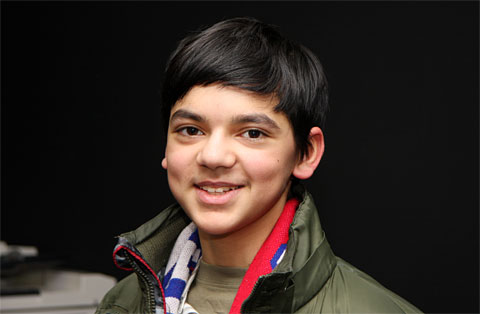 Anish Giri Anish Giri - Friso Nijboer Dutch National Championship, Round 7 Haaksbergen, 18 September 2009 West India Game: King's Indian Defense (Main Line) 1.d4 Nf6 2.c4 g6 3.Nc3 Bg7 4.e4 d6 5.Nf3 0-0 6.Be2 e5 7.0-0 Nc6 8.d5 Ne7
9.Ne1
9...Nd7 10.Nd3
10...f5 11.Bd2 Nf6 12.f3 f4 13.c5 g5 14.Rc1
14...Ng6 15.Nb5
15...a6
!""""""""# $t+vW Tl+% $+oO + Vo% $o+ O Mm+% $+nPpO O % $ + +pO +% $+ +n+p+ % $pP Bb+pP% $+ Rq+rK % /(((((((() WHITE: Anish Giri Position after 15...a7a6 16.cxd6!?
16...axb5 17.dxc7 Qd7
18.Bb4!?
18...g4!?
19.Nc5
19...Qxc7 20.Ne6!
20...Qf7?
!""""""""# $t+v+ Tl+% $+o+ +wVo% $ + +nMm+% $+o+pO + % $ B +pOo+% $+ + +p+ % $pP +b+pP% $+ Rq+rK % /(((((((() WHITE: Anish Giri Position after 20...Qc7f7 21.Bxb5!
21...gxf3
22.Ng5 fxg2 23.Rf2!
23...Bg4 24.Qb3 Rfc8 25.Rfc2
25...Rxc2 26.Rxc2 Nh4
27.Nxf7 Kxf7 28.Rc7+ Kg6
29.h3 f3
30.Be1
30...Bh6
31.Bxh4
!""""""""# $t+ + + +% $+oR + +o% $ + + MlV% $+b+pO + % $ + +p+vM% $+q+ +o+p% $pP + +o+% $+ + B K % /(((((((() WHITE: Anish Giri Position after 30...Bg7h6 31...Rxa2 32.Qxa2 Be3+ 33.Bf2 Bxf2+ 34.Kxf2 Nxe4+ 35.Kg1 Ng5
36.Bd3+ Kf6 37.Rxh7 1-0
|
| Printer Friendly | Permalink | | Top |
| Jack Rabbit
|
Sun Sep-27-09 02:14 AM Response to Reply #2 |
| 4. Zhao Xue - Hou Yifan, Maotai Prince Cup, Jinzhou |
 Hou Yifan Xhao Xue - Hou Yifan Maotai Prince Cup (Women's Group), Round 3 Jinzhou, 19 September 2009 East India Game: Nimzo-Indian Defense 1.c4 Nf6 2.Nf3 e6 3.Nc3 d5 4.d4 Bb4 5.Qa4+
5...Nc6 6.e3 0-0 7.a3
7...Bxc3+ 8.bxc3 Ne4
9.Qc2 b6 10.cxd5 exd5 11.Bd3 Re8
12.0-0 Na5!?
13.a4
13...c5 14.Nd2!?
!""""""""# $t+vWt+l+% $O + +oOo% $ O + + +% $M Oo+ + % $p+ Pm+ +% $+ PbP + % $ +qN PpP% $R B +rK % /(((((((() WHITE: Zhao Xue Position after 14.Ne4d2 14...Bf5!
15.Nxe4 Bxe4 16.dxc5 Bxd3 17.Qxd3 Nb3!
18.Ra3 Nxc5 19.Qe2
19...Rc8 20.Rd1 Ne4 21.Bb2 h6!?
22.a5
22...bxa5 23.Ra4 Qb6
24.Rxd5 Rb8 25.Ba1 Qc6!?
26.Raxa5 Re5 27.c4?
27...Rb1+!
28.Rd1
!""""""""# $ + + +l+% $O + +oO % $ +w+ + O% $R + T + % $ +p+m+ +% $+ + P + % $ + +qPpP% $Bt+r+ K % /(((((((() WHITE: Zhao Xue Position after 28.Rd4d1 28...Qxc4!!
29.Rxb1
29...Qxe2 30.Bxe5 Qxf2+ 31.Kh1 Qxe3 32.h3
32...Nd2 33.Rb8+
33...Kh7 34.Bc7 Qe1+ 35.Kh2 Nf1+ 0-1
|
| Printer Friendly | Permalink | | Top |
| Jack Rabbit
|
Sun Sep-27-09 02:15 AM Response to Reply #2 |
| 5. Efimenko - Short, Match, Mukachevo |
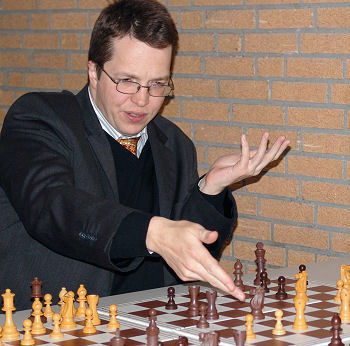 Nigel Short Zahar Efimenko - Nigel Short Match, Round 2 Mukachevo, 21 September 2009 Spanish Grand Royal Game: Gothic Defense (Open Defense) 1.e4 e5 2.Nf3 Nc6 3.Bb5 a6 4.Ba4 Nf6 5.0-0 Nxe4 6.d4 b5 7.Bb3 d5 8.dxe5 Be6 9.Nbd2
9...Nc5 10.c3 g6
11.Bc2 Bg7 12.Re1 0-0
13.Nb3 Nd7!?
14.Bg5 Qc8 15.Bf4 Ne7
16.Qd2 c5 17.Bh6
17...Qc6
18.Qg5
18...Rfe8 19.Bxg7 Kxg7 20.h4!?
20...a5
21.a4 h6 22.Qf4 Reb8
23.Nbd2 b4 24.c4
!""""""""# $tT + + +% $+ +mMoL % $ +w+v+oO% $O OoP + % $pOp+ Q P% $+ + +n+ % $ OvN Pp+% $R + R K % /(((((((() WHITE: Zahar Efimenko Position after 24.c3c4 24...b3!?
25.Bxb3
25...Rb4 26.cxd5
26...Nxd5 27.Bxd5 Bxd5 28.Qe3 Nf8
29.b3 Ne6 30.Rac1!?
!""""""""# $t+ + + +% $+ + +oL % $ +w+m+oO% $O OvP + % $pT + + P% $+p+ Qn+ % $ + N Pp+% $+ R R K % /(((((((() WHITE: Zahar Efimenko Position after 30.Ra1c1 30...Qb7!
31.Rc3 Rd8 32.Rd3?
32...Bxf3 33.Nxf3
33...Rxd3 34.Qxd3 Rxb3! !""""""""# $ + + + +% $+w+ +oL % $ + +m+oO% $O O P + % $p+ + + P% $+t+q+m+ % $ + + Pp+% $+ + R K % /(((((((() WHITE: Zahar Efimenko Position after 34...Rb2b3:p
35.Qd1 Rb4 36.h5 g5
37.Qc2 Qc6 38.Ra1 Rg4 39.Qf5
39...Rf4 40.Qc2 Rg4 41.Qf5 Rf4
42.Qc2 Kg8 43.Qd1 Rb4
44.g3 !""""""""# $ + + +l+% $+ + +o+ % $ +w+m+ O% $O O P Op% $pT + + +% $+ + +nP % $ + + P +% $R +q+ K % /(((((((() WHITE: Zahar Efimenko Position after 44.g2g3 44...Qe4!
45.Nd2 Qxe5 46.Rc1 Qd5 47.Qc2 g4!
48.Re1 Qxh5 49.Qd3
49...Rd4 50.Qe3 Ng5 51.Qe8+
51...Kh7 52.Re2 !""""""""# $ + +q+ +% $+ + +o+l% $ + + + O% $O O + Mw% $p+ T +o+% $+ + + P % $ + NrP +% $+ + + K % /(((((((() WHITE: Zahar Efimenko Position after 52.Re1e2 52...Rxd2!! 0-1
|
| Printer Friendly | Permalink | | Top |
| Jack Rabbit
|
Sun Sep-27-09 02:17 AM Response to Reply #1 |
| 6. SPICE Cup. Texas Tech University, Lubbock |
| Printer Friendly | Permalink | | Top |
| Jack Rabbit
|
Sun Sep-27-09 02:18 AM Response to Reply #6 |
| 7. Hammer - So, Group A, Round 2 |
|
Edited on Sun Sep-27-09 02:20 AM by Jack Rabbit
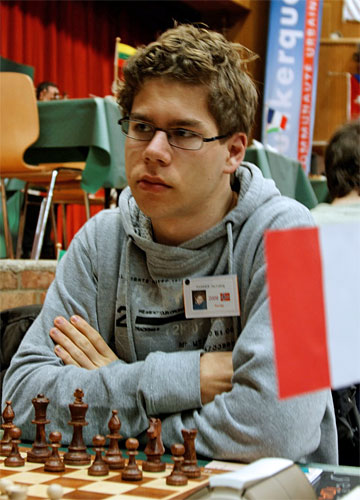 Jon Ludvig Hammer Jon Ludvig Hammer - Wesley So SPICE Cup, Round 2 Texas Tech University, 19 September 2009 Slav Queen's Gambit: Karlsbad Defense 1.d4 d5 2.c4 c6 3.Nf3 Nf6 4.Nc3 dxc4 5.a4 Bf5 6.Ne5
6...Nbd7 7.Nxc4 Nb6
8.Ne3
8...e6!?
9.a5
9...Nbd5 10.Nxf5 exf5 11.a6 b6 12.g3 Bb4 13.Bd2 0-0
14.Bg2 Qe7 15.0-0 Rac8!?
!""""""""# $ +t+ Tl+% $O + WoOo% $pOo+ M +% $+ +m+o+ % $ B P + +% $+ N + P % $ P BpPbP% $R +q+rK % /(((((((() WHITE: Jon Ludvig Hammer Position after 15...Ra8c8 16.Nxd5!
16...Nxd5 17.e3 Rfd8 18.Bxb4 Nxb4
19.Qb3 c5 20.dxc5 Qxc5
21.Rfd1 g6!?
22.Bb7!
22...Rxd1+ 23.Qxd1 Rc7
24.Qd8+ Kg7 25.Rd1 h5?
!""""""""# $ + Q + +% $ObT +oL % $ O + +o+% $+ W +o+o% $ M + + +% $+ + P P % $ P + P P% $+ +r+ K % /(((((((() WHITE: Jon Ludvig Hammer Position after 25...h7h5 26.Rd6!
26...Qc1+ 27.Rd1!?
27...Qc4?
28.Rd6 Qc1+ 29.Kg2 Nc2
30.Qf6+ Kh7 31.Rd8 Nxe3+ 32.fxe3!?
32...Rc2+
!""""""""# $ + R + +% $Ob+ +o+l% $pO + Qo+% $+ + +o+o% $ + + + +% $+ + P P % $ Pt+ +kP% $+ W + + % /(((((((() WHITE: Jon Ludvig Hammer Position after 32...Rc7c2+ 33.Kh3 Qf1+ 34.Kh4 Qc4+
35.Rd4 Rxh2+ 36.Kg5 Qc7 37.Qd6 f6+ 38.Kxf6 Qg7+ 39.Ke6 Qg8+ 40.Kd7 Rc2
41.Qe7+ Kh6 42.Rd6 Rc5 43.Bc6! 1-0
|
| Printer Friendly | Permalink | | Top |
| Jack Rabbit
|
Sun Sep-27-09 02:22 AM Response to Reply #6 |
| 8. Robson - Papp, Group B, Round 6 |
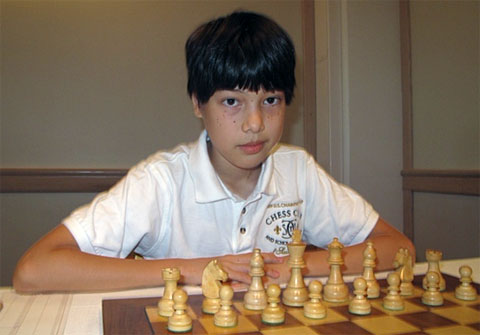 Ray Robson Ray Robson - Gabor Papp SPICE Cup (Group B), Round 6 Texas Tech University, 24 September 2009 Open Sicilian Game: Rat Dragon Defense (Yugoslav Opening) 1.e4 c5 2.Nf3 d6 3.d4 cxd4 4.Nxd4 Nf6 5.Nc3 g6 6.Be3 Bg7 7.f3 0-0
8.Qd2 Nc6 9.Bc4 Bd7 10.0-0-0 Rb8
11.Bb3 Na5 12.Bh6 Bxh6
13.Qxh6 b5 14.Nd5!?
14...Nxb3+
15.Nxb3 e5 16.h4 Nxd5 17.Rxd5 Rb6
18.f4 Be6 19.h5 Qe7 20.Rd3 exf4
21.Qxf4 g5 22.Qe3 h6
23.Nd4 Rc8 24.Re1 b4 25.e5
25...d5!?
26.Rf1
26...Qc7
27.Rf6 Bd7?
!""""""""# $ +t+ + +% $O Wv+o+ % $ T + R O% $+ +oP Op% $ O N + +% $+ +rQ + % $pPp+ +p+% $+ K + + % /(((((((() WHITE: Ray Robson Position after 27...Be6d7 28.Rxh6!!
28...Rxh6 29.Qxg5+!
29...Kh7 30.Rg3!
30...Bg4
31.Rxg4 f6 32.exf6 a5
33.Qf5+ Kh8 !""""""""# $ +r+ + K% $+ W + + % $ + + P R% $O +o+q+p% $ O N +r+% $+ + + + % $pPp+ +p+% $+ K + + % /(((((((() WHITE: Ray Robson Position after 33...Kh7h8 34.f7!
34...Rf8 35.Qg5 1-0
|
| Printer Friendly | Permalink | | Top |
| Jack Rabbit
|
Sun Sep-27-09 02:23 AM Response to Reply #1 |
| 9. Inventi International Tournament, Antwerp |
| Printer Friendly | Permalink | | Top |
| Jack Rabbit
|
Sun Sep-27-09 02:24 AM Response to Reply #9 |
| 10. Sutovsky - Timman, Round 5 |
 Emil Sutovsky Emil Sutovsky - Jan Timman Inventi International Tournament, Round 5 Antwerp, 22 September 2009 Epine Dorsal: Horseman Defense (Jaenisch Opening) (Petroff Defense) 1.e4 e5 2.Nf3 Nf6 3.Nxe5
3...d6 4.Nf3 Nxe4 5.d4 d5 6.Bd3 Bd6 7.0-0 0-0 8.c4 c6 9.Re1
9...Bg4
10.Bxe4
10...dxe4 11.Rxe4 f5 12.Re6
12...Bc7 13.Nbd2?
13...Qxd4 14.Nxd4 Bxd1
15.b3 Bh5 16.Ba3 Rd8
17.N2f3 Bxf3
18.gxf3!?
18...Nd7?
!""""""""# $t+ T +l+% $OoVm+ Oo% $ +o+r+ +% $+ + +o+ % $ +pN + +% $Bp+ +p+ % $p+ + P P% $R + + K % /(((((((() WHITE: Emil Sutovsky Position after 18...Nb8d7 19.Nxf5!
19...Re8
20.Rae1 Rxe6 21.Rxe6 Be5
22.Re7!
22...Rd8 23.Bd6 Bxd6 24.Nxd6 Nc5
25.Nxb7 Rd1+ 26.Kg2 Nd3
!""""""""# $ + + +l+% $On+ R Oo% $ +o+ + +% $+ + + + % $ +p+ + +% $+p+m+p+ % $p+ + PkP% $+ +t+ + % /(((((((() WHITE: Emil Sutovsky Position after 26...Nc5d3 27.Re8+!
27...Kf7 28.Nd6+ Kg6
29.Re4 h5 30.h4 Kf6 31.f4 Nc5
32.Re5! Nd3
33.Ne4+ Kg6 34.f5+ 1-0
|
| Printer Friendly | Permalink | | Top |
| Jack Rabbit
|
Sun Sep-27-09 02:25 AM Response to Reply #9 |
| 11. Howell - Bacrot, Round 2 |
|
Edited on Sun Sep-27-09 02:26 AM by Jack Rabbit
 Etienne Bacrot David Howell - Etienne Bacrot Inventi International Tournament, Round 2 Antwerp, 19 September 2009 Italian Clam Opening: Horseman Defense (King's Bishop Game) 1.e4 e5 2.Bc4
2...Nf6 3.d3
3...c6
4.Nf3 d5
5.Bb3 Bd6 6.exd5 cxd5
7.0-0
7...Nc6 8.Re1!?
8...Be6
9.Bg5 a6 10.Nc3
10...Bc7 11.Bh4 0-0 12.Bg3!?
!""""""""# $t+ W Tl+% $+oV +oOo% $o+m+vM +% $+ +oO + % $ + + + +% $+bNp+nB % $pPp+ PpP% $R +qR K % /(((((((() WHITE: David Howell Position after 12.Bh4g3 12...d4!
13.Bxe6 dxc3
14.Bb3 cxb2 15.Rb1 e4!?
16.Bxc7 Qxc7 17.dxe4
17...Rad8 18.Qe2 Rfe8 19.Ng5!?
19...Rd7
20.f3
20...Ne5 21.Rxb2 h6
22.Nh3 !""""""""# $ + +t+l+% $+oWt+oO % $o+ + M O% $+ + M + % $ + +p+ +% $+b+ +p+n% $pRp+q+pP% $+ + R K % /(((((((() WHITE: David Howell Position after 24.Qe2f2 22...Neg4!!
23.fxg4 Rxe4 24.Qf2?
24...Nxg4!
25.Rxe4 Rd1+ 26.Qe1
26...Rxe1+ 27.Rxe1 Qb6+ 28.Kh1 Qd6
29.Bxf7+
!""""""""# $ + + +l+% $+O+ +bO % $o+ W + O% $+ + + + % $ + + +m+% $+ + + +n% $pRp+ +pP% $+ + R +k% /(((((((() WHITE: David Howell Position after 29.Bb3f7:p+ 29...Kf8!
30.Kg1 Qd4+!
31.Kh1 Qxb2
32.Be6 Qb4 33.Rf1+
33...Ke7 34.Nf4 Nf2+ 35.Kg1 Qxf4 36.Bb3 !""""""""# $ + + + +% $+o+ L O % $o+ + + O% $+ + + + % $ + + W +% $+b+ + + % $p+p+ MpP% $+ + +rK % /(((((((() WHITE: David Howell Position after 36.Be6b3 36...Nh3+!!
37.gxh3 Qg5+ 38.Kh1 b5 39.Re1+ Kd7 40.a4
40...bxa4 41.Bxa4+ Kc7
42.Bb3 a5 43.Re4 Qc1+ 44.Kg2 Qd2+ 45.Kg1
45...g5 46.Re7+ Kd8 47.Re4 h5 48.Rc4
48...g4 49.hxg4 h4 0-1
|
| Printer Friendly | Permalink | | Top |
| Jack Rabbit
|
Sun Sep-27-09 02:27 AM Response to Reply #9 |
| 12. Michiels - A. Muzychuk, Round 4 |
 Anna Muzychuk Bart Michiels - Anna Muzychuk Inventi International Tournament, Round 4 Antwerp, 21 September 2009 Open Sicilian Game: Taimanov Defense (Szen Variation) 1.e4 c5 2.Nf3 e6 3.d4 cxd4 4.Nxd4 Nf6 5.Nc3 Nc6
6.Ndb5 Bc5
7.Bf4
7...0-0 8.Bc7 Qe7 9.Bd6 Bxd6 10.Qxd6 Qd8
11.Qc7!?
11...d5!
12.Qxd8!?
12...Rxd8 13.exd5 exd5 14.Rd1
14...Bf5!
15.Nc7 Bxc2 16.Rd2
16...Rac8
17.N7xd5 Nxd5 18.Rxd5 !""""""""# $ +tT +l+% $Oo+ +oOo% $ +m+ + +% $+ +R+ + % $ + + + +% $+ N + + % $pPv+ PpP% $+ + Kb+r% /(((((((() WHITE: Bart Michiels Position after 18.Rd2d5:N 18...Nb4!?
19.Rxd8+ Rxd8 20.a3 Nd3+
21.Bxd3 Bxd3 22.h4 f6 23.Rh3
23...Kf7 24.Re3 Rd4 25.f4 a5
26.g3 b5 27.Ne2 Rd7 28.Nc3
28...Kg6 29.Kd2 Bf5+ 30.Ke1 Bd3 31.Kd2 Bc4+ 32.Kc2
32...a4 33.Ne4 Bb3+ 34.Kc3 Rc7+!?
!""""""""# $ + + + +% $+ T + Oo% $ + + Ol+% $+o+ + + % $o+ +nP P% $PvK R P % $ P + + +% $+ + + + % /(((((((() WHITE: Bart Michiels Position after 34...Rd7c7:p+ 35.Kb4!
35...Rc2
36.Kxb5 Rxb2 37.Nc5 Bd1+
38.Ka5
38...Rb8 39.Re7 h5!?
40.Ne6 Rg8 41.Nd4 Rd8
42.Ne6 Rd3 43.Nxg7 !""""""""# $ + + + +% $+ + R N % $ + + Ol+% $K + + +o% $o+ + P P% $P +t+ P % $ + + + +% $+ +v+ + % /(((((((() WHITE: Bart Michiels Position after 43.Ne6g7:p 43...f5!
44.Ne8
44...Rxa3 45.Rg7+!
45...Kh6 46.Rg5!?
46...Rd3 47.Nf6
47...Rd6 48.Ng8+!?
48...Kh7 49.Kb4 Re6 50.Ka3 Bb3 51.Rxh5+
51...Kxg8 52.Rxf5
!""""""""# $ + + +l+% $+ + + + % $ + +t+ +% $+ + +r+ % $o+ + P P% $Kv+ + P % $ + + + +% $+ + + + % /(((((((() WHITE: Bart Michiels Position after 51.Rh5f5:p 52...Re3!
53.Rg5+ Kf7 54.Kb4?
54...Bd1
55.h5 a3 56.Rf5+ Kg7 57.Rd5 Rb3+ 58.Kc4
!""""""""# $ + + + +% $+ + + L % $ + + + +% $+ +r+ +p% $ +k+ P +% $Ot+ + P % $ + + + +% $+ +v+ + % /(((((((() WHITE: Bart Michiels Position after 58.Kb4c4 58...a2!!
59.Rxd1 Rb1 60.Rd7+ Kh6 61.Ra7 a1Q 62.Rxa1 Rxa1 63.Kd5 Kxh5 0-1
|
| Printer Friendly | Permalink | | Top |
| Jack Rabbit
|
Sun Sep-27-09 02:29 AM Response to Reply #1 |
| 13. Cuna de Ajedrez Moderno Rapid Match, Valencia |
| Printer Friendly | Permalink | | Top |
| Jack Rabbit
|
Sun Sep-27-09 02:30 AM Response to Reply #13 |
| 14. Kasparov - Karpov, Round 2 |
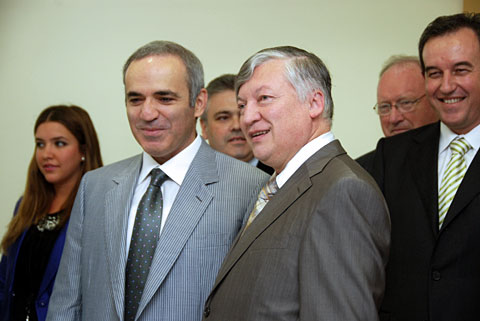 Garry Kasparov and Anatoly Karpov in Valencia Garry Kasparov - Anatoly Karpov Cuna de Ajedrez Moderno Rapid Match, Round 2 Valencia, 22 September 2009 Orthodox Queen's Gambit: Exchange Opening 1.d4 d5 2.c4 e6 3.Nc3 Be7 4.cxd5
4...exd5 5.Bf4 c6
6.Qc2
6...Bd6 7.Bxd6
7...Qxd6 8.e3 Ne7
9.Bd3 Nd7
10.Nge2!?
10...h6!?
11.0-0 0-0 12.a3 a5
13.Rad1
13...b6
14.e4 dxe4
15.Nxe4 Qb8!?
16.N2c3 Ba6
17.Bxa6 Rxa6 !""""""""# $ W + Tl+% $+ +mMoO % $tOo+ + O% $O + + + % $ + Pn+ +% $P N + + % $ Pq+ PpP% $+ +r+rK % /(((((((() WHITE: Garry Kasparov Position after 17...Ra8a6:B 18.d5!
18...Nxd5
19.Nxd5 cxd5 20.Rxd5 Ra7
21.Qd2 Nc5?
!""""""""# $ W + Tl+% $T + +oO % $ O + + O% $O Mr+ + % $ + +n+ +% $P + + + % $ P Q PpP% $+ + +rK % /(((((((() WHITE: Garry Kasparov Position after 21...Nd7c5 22.Nf6+!!
22...gxf6 23.Qxh6 f5 24.Qg5+!
24...Kh8 25.Qf6+ Kg8 26.Rxf5 Ne4
27.Qh4 Re8 28.Rh5 f5 1-0
|
| Printer Friendly | Permalink | | Top |
| Jack Rabbit
|
Sun Sep-27-09 02:31 AM Response to Reply #13 |
| 15. Karpov - Kasparov, Round 3 |
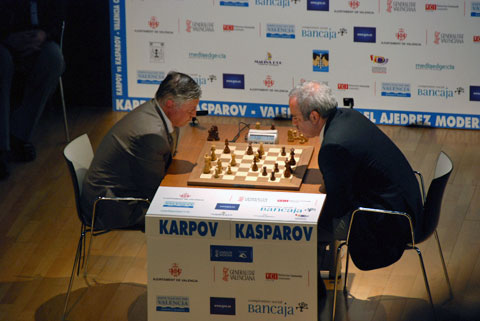 Anatoly Karpov and Garry Kasparov in Valencia Anatoly Karpov - Garry Kasparov Cuna del Ajedrez Moderno Rapid Match, Round 3 Valencia, 23 September 2009 West India Game: Indian Queen's Gambit (Gr�nfeld Defense) 1.d4 Nf6 2.c4 g6 3.g3 Bg7 4.Bg2 d5 5.cxd5 Nxd5 6.e4
6...Nb6 7.Ne2 c5 8.d5 e6 9.0-0 0-0 10.Nec3 10...Na6 11.a4
11...exd5 12.exd5 Nb4!?
13.Be3
13...Bd4!?
14.a5!
16...Bf5 17.Na3 Rxa7!?
18.Ncb5! Rxa3?!
19.Rxa3 Bxb2 20.Re3 Qb6?!
!""""""""# $ + + Tl+% $+o+ +o+o% $ W + +o+% $+nOp+v+ % $ M + + +% $+ + R P % $ V + PbP% $+ +q+rK % /(((((((() WHITE: Anatoly Karpov Position after 20...Qd8b6 21.Qe2!
21...Bg7 22.Rd1 Bd7 23.Na3 Bd4 24.Re7!
24...Ba4 25.Rc1
25...Qf6 26.Rxb7 Bb2 27.Rxc5 Bxa3 28.h4 Nd3 29.Ra5!
29...Nc5 30.Rba7 Qd4 31.Qe3 Qxe3 32.fxe3 Bc1 33.Kf2 Nd3+?
!""""""""# $ + + +l+% $R + +o+o% $ + + +o+% $R +p+ + % $v+ + + P% $+ +mP P % $ + + Kb+% $+ V + + % /(((((((() WHITE: Anatoly Karpov Position after 33...Nc5d3 34.Ke2!
34...Bc2
35.d6!
35...Re8 36.Ra8 1-0
|
| Printer Friendly | Permalink | | Top |
| Jack Rabbit
|
Sun Sep-27-09 02:33 AM Response to Original message |
| 16. Bonus Game: Kasparov - Karpov, Match, Lyon, 1990 |
|
Please click the picture . . .
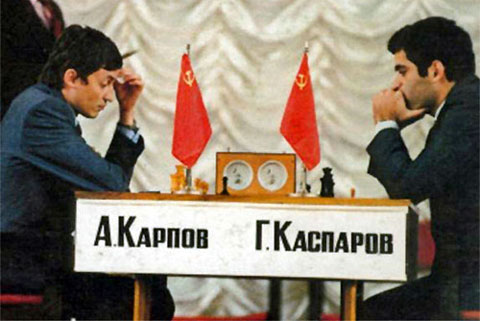 Anatoly Karpov (left) and Garry Kasparov palyed five matches for the world title from 1984 through 1990 Garry Kasparov - Anatoly Karpov 5th Match for the World Title, Round 20 Lyon, 15 December 1990 Spanish Grand Royal Game: Zaitsev Defense 1.e4 e5 2.Nf3 Nc6 3.Bb5 a6 4.Ba4 Nf6 5.0-0 Be7 6.Re1 b5 7.Bb3 d6 8.c3 0-0 9.h3 Bb7
10.d4 Re8 11.Nbd2 Bf8 12.a4 h6
13.Bc2
13...exd4 14.cxd4 Nb4 15.Bb1 c5 16.d5 Nd7 17.Ra3 f5
18.Rae3
18...Nf6 19.Nh2 Kh8
20.b3!?
20...bxa4
21.bxa4 c4!?
22.Bb2 fxe4 23.Nxe4 Nfxd5?!
24.Rg3!?
!""""""""# $t+ WtV L% $+v+ + O % $o+ O + O% $+ +m+ + % $pMo+n+ +% $+ + + Rp% $ B + PpN% $+b+qR K % /(((((((() WHITE: Garry Kasparov Position after 24.Re3g3 24...Re6!
25.Ng4?
25...Qe8 26.Nxh6
26...c3 27.Nf5 cxb2 28.Qg4 Bc8
29.Qh4+?
29...Rh6?
!""""""""# $t+v+wV L% $+ + + O % $o+ O + T% $+ +m+n+ % $pN +n+ Q% $+ + + Rp% $ O + Pp+% $+b+ R K % /(((((((() WHITE: Garry Kasparov Position after 29...Re6h6 30.Nxh6!
30...gxh6 31.Kh2
31...Qe5 32.Ng5 Qf6 33.Re8 Bf5
!""""""""# $t+ +rV L% $+ + + + % $o+ O W O% $+ +m+vN % $pM + + Q% $+ + + Rp% $ O + PpK% $+b+ + + % /(((((((() WHITE: Garry Kasparov Position after 33...Bc8f5 34.Qxh6+!
34...Qxh6 35.Nf7+ Kh7 36.Bxf5+ Qg6 37.Bxg6+
37...Kg7 38.Rxa8 Be7
39.Rb8 a5 40.Be4+ Kxf7 41.Bxd5+ 1-0
|
| Printer Friendly | Permalink | | Top |
| Jack Rabbit
|
Tue Sep-29-09 05:25 PM Response to Original message |
| 17. Update (Tuesday): Doubleheader starts in Nanjing; 3-way tie at Texas Tech |
|
Chess Doubleheader Begins in Nanjing
 The second annual Pearl Spring Chess Tounament and the second leg of of the 2009-10 FIDE Women's Grand Prix began yesterday (Monday) afternoon at the Pearl Spring Holiday Resort Hotel in the former Chinese capital of Nanjing. The Pearl Spring Tournament is a double round robin among six players: Magnus Carlsen (Norway), Dmitry Jakovenko (Russia), Peter Leko (Hungary), Teimour Radjabov (Azerbaijan), former FIDE champion Veselin Topalov (Bulgaria) and Wang Yue (China). As was the case last year, the Pearl Spring is a grand slam tournament. The winner will play in Bilbao, Biscay Province (Spain) next August against the winners of the Corus A in Wijk aan Zee, the international tournament in Linares and the MTel Masters in the Bulgarian capital, Sofia. So far, Magnus Carlsen has won both of his first two games, yesterday against Leko and today against Topalov. No other play has won a game. The grand prix is being played among 12 women: nana Dzagnidze (Georgia), Martha Fierro (Ecuador), Ju Wengen (China), Bara Kovanova (Russia), Lilit Mkrtchian (Armenia), Batkuyag Munguntuul (Mongolia), Marie Sebag (France), Shen Yang (China), Xu Yuhua (China), Yildiz (Turkey), Zhao Xue (China) and Zhu Chen (Qatar). After two rounds, Ms. Dzagnidze is the only player with a perfect score. She is followed the two former world women's champions, Zhu Chen and Zu Yuhua, with a point and a half each. The first leg of the Women's Grand Prix was play earlier this year in Istanbul and was won by Indian GM Koneru Humpy. The four remaining tournaments in the series will be played in Nalchik in the Russian Caucaus in April; Jermuk, Armenia in June and July; the Mongolian capital of Ulan Bator in July and August; and Santiago, Chile, in Octobe and November, 2010. The action in both tournaments begins at 3 pm Nanjing time (Midnight PDT) and may be followed on the official website of the both tournaments. SPICE Cup Group A Ends in 3-Way Tie http://4.bp.blogspot.com/_Q0lTtPVTG40/Sqlz4zfpsTI/AAAAAAAA7_o/FabWgEut9uc/S217/2009+SPICE+Cup+TTU+Cover+2.tif.jpg Rauf Mamedov of Azerbaijan defeated Norway's Jon Ludvig Hammer to join Ukrainian GM Yuriy Kuzubov and Dmitry Andeikin of Russia as co-champions of the 2009 SPICE Cup at Texas Tech University in Lubbock. Jon Ludvig had been leading the tournament with Kuzubov and Andeikin most of the way. but dropped each of his last two games to fall back. The event saw a number of fighting draws but few decisive game. Mamedov, Kuzubov and Andeikin each won only one game while drawing nine to share first place. |
| Printer Friendly | Permalink | | Top |
| two gun sid
|
Tue Sep-29-09 10:56 PM Response to Original message |
| 18. Thr JR Chess Report Staff does it again! |
|
Good work. The staff rocks!
|
| Printer Friendly | Permalink | | Top |
| DU
AdBot (1000+ posts) |
Sun May 05th 2024, 07:02 AM Response to Original message |
| Advertisements [?] |
| Top |
| Home » Discuss » Topic Forums » Sports |
|
Powered by DCForum+ Version 1.1 Copyright 1997-2002 DCScripts.com
Software has been extensively modified by the DU administrators
Important Notices: By participating on this discussion board, visitors agree to abide by the rules outlined on our Rules page. Messages posted on the Democratic Underground Discussion Forums are the opinions of the individuals who post them, and do not necessarily represent the opinions of Democratic Underground, LLC.
Home | Discussion Forums | Journals | Store | Donate
About DU | Contact Us | Privacy Policy
Got a message for Democratic Underground? Click here to send us a message.
© 2001 - 2011 Democratic Underground, LLC